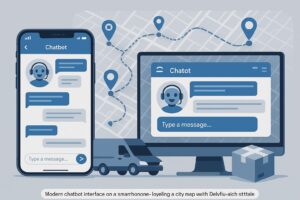Prompt-based chatbots let your teams and customers simply ask for what they need (“postpone delivery to tomorrow,” “ETA for route 12,” “create a damage ticket”) and get it done instantly—no menus, no waiting. When paired with action workflows and your logistics stack, they become a 24/7 co-pilot for customer support and operations.
Why prompt-based and why now?
Logistics is real-time, multi-party, and high-stakes. Phone queues and email threads don’t scale when delivery windows tighten and exceptions spike. Modern AI is finally good enough to handle free-form language, route it to the right action, and return authoritative results from your systems—at any hour.
Industry leaders are already using AI agents to shrink response times, accelerate routing decisions, and resolve disruptions faster (e.g., Uber Freight’s AI cut average customer wait time from ~5 minutes to ~30 seconds). That’s the difference between a missed SLA and a delighted shipper.
What a prompt-based chatbot does in logistics
Think of a chat window as a universal command line for your operation:
-
Order & delivery self-service
“Where’s my parcel?” → Live status + map + next ETA.
“Change drop-off to parcel locker.” → Validate + update + confirm. -
Actionable support
“Create a ticket for a damaged package on route 7.” → Pre-filled case with photos, SLA timer, and customer notification. -
Ops co-pilot for dispatch
“Show late-risk stops on Stockholm North and suggest help-shift split.” → Surface candidates and create a micro-route. (Bonus: combine with a route engine for smarter suggestions.) -
Driver assistance
“Next three stops with access codes” → Securely fetch and display.
“Report failed delivery” → Capture reason, reschedule, notify receiver. -
Exception handling
“Traffic incident on E4—what’s the impact?” → Recompute ETAs and notify affected customers proactively.
The hybrid model that works: Prompt-based + Action-based
Pure Q&A is not enough. In logistics, the chatbot must do things—cancel, postpone, re-route, open tickets, update webhooks—safely.
Trendplus’s approach is a hybrid:
-
Prompt-based intelligence to understand free-form requests from customers, drivers, and ops.
-
Action-based workflows with guardrails to execute tasks in your systems (TMS/WMS/OMS, ticketing, CRM), log every step, and return a verifiable outcome.
This pairing turns a helpful bot into an operations orchestration layer that scales without adding headcount.
High-impact use cases (you can deploy first)
-
Delivery changes & postponements – authenticated customers reschedule in seconds; no agent time required.
-
Proactive delay comms – detect risk, push new ETAs, and offer time slots automatically.
-
Returns & claims – structured flows that collect proofs, create RMAs, and sync to ERP.
-
Driver self-service – pickup confirmations, NDR codes, POD uploads, voice-to-text notes.
-
Help-shift routing assist – identify overflow routes and propose parcel splits to a standby driver.
Design principles for a production-grade logistics chatbot
-
Ground answers in your systems of record
Every response cites a source (TMS/OMS/WMS) and shows the latest authoritative status. -
Strong authentication & permissions
Customers, drivers, and ops get role-appropriate actions (e.g., only dispatch can trigger help-shift). -
Deterministic workflows for critical actions
Natural language in, structured checklists out (validations, approvals, audit trails). -
Routing intelligence as a backbone
Pair with a route engine to recompute ETAs and options on demand—your bot becomes decision-aware, not just chatty. -
Human-in-the-loop for edge cases
Seamless handoff to an agent with full context when confidence is low or risk is high.
What to integrate first
-
Data sources: orders, stops, ETAs, customer profiles, SLA rules.
-
Actions: postpone/cancel delivery, address updates, proof capture, ticketing.
-
Channels: website, tracking portal, WhatsApp, SMS, driver app, and internal Slack/Teams.
-
Observability: conversation logs, workflow metrics, cost per resolution, containment rate.
KPIs that prove ROI
-
Median time-to-answer and time-to-resolution (target: seconds, not minutes).
-
Self-service containment rate (share of issues resolved without human agents).
-
Proactive save rate (late-risk orders notified & acknowledged before deadline).
-
Cost per contact vs. phone/email baseline, and CSAT/NPS lift from instant updates.
Example prompts your teams and customers can use today
-
“Move delivery #TR-984213 to tomorrow after 18:00 and notify the receiver.”
-
“Create a damage claim for route 12, stop 6; attach the driver’s photos.”
-
“Show late-risk orders in Gothenburg and propose a help-shift split.”
-
“Add entrance code for Eriksgatan 5 and share with the driver.”
-
“Send the latest ETA for order 55321 to the recipient via SMS.”
Each prompt maps to a validated workflow, not just an answer.
How Trendplus can help
TrendBot is our hybrid prompt-based + action-based chatbot built specifically for logistics and transportation. It plugs into your stack, executes guarded workflows, and pairs beautifully with TrendRoute, our AI route optimization engine, to keep ETAs honest and customers informed.
-
Built-in flows for postponements, cancellations, and ticketing
-
Secure logins for customers and drivers
-
Real-time ETA and status lookups
-
Audit-ready action logs and analytics dashboards
Ready to see it live?
If you’re aiming to reduce wait times, deflect repetitive contacts, and keep SLAs intact even on hectic days, a prompt-based chatbot is the fastest lever to pull. Book a short demo and we’ll map your top three use cases to live workflows.





